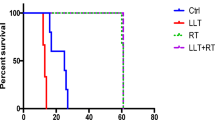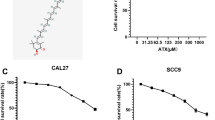Abstract
Radiation therapy for head and neck squamous cell carcinoma (HNSCC) is associated with several complications. Although photobiomodulation (PBM) has radioprotective effects in normal tissue, it could also enhance the growth of neoplastic cells. Thus, the present study aimed to investigate the cellular response of oral squamous cell carcinoma with pre-exposure to low-level phototherapy before radiotherapy. SCC9, Cal-27, A431, and HaCaT cell lines were subjected to low-level light therapy and radiotherapy. The cells were treated with a single energy density (300 J/cm2) of a light-emitting diode (660 nm) prior to ionizing radiation at different doses (0, 2, 4, and 6 Gy). After 24 h, wound scratch, proliferation, clonogenic cell survival, cell death, and reactive oxygen species (ROS) analyses were performed to evaluate cell response. The cell lines pre-exposed to PBM at the analyzed dosage were radiosensitive. The treatment significantly reduced cell proliferation and clonogenic cell survival. Migration and cell death assays also revealed positive results, with the treatment group showing lower rate of migration and higher cell death than did the control group. Moreover, PBM effectively increased the intracellular levels of ROS. PBM at 300 J/cm2 is a promising radiosensitizing modality to reduce the radiation dose and avoid the intolerable side effects of radiotherapy for HNSCC, thus increasing the probability of successful treatment. However, further studies are needed to support and confirm the results.





Similar content being viewed by others
Abbreviations
- A431:
-
Epidermoid carcinoma cell line
- AO:
-
Acridine orange
- Cal-27:
-
OSCC cell line
- DEMEM/Ham’s F-12:
-
Dulbecco’s modified Eagle’s medium/nutrient medium
- EB:
-
Ethidium bromide
- HaCaT:
-
Skin keratinocyte cell line
- HNSCC:
-
Head and neck squamous cell carcinoma
- IR:
-
Ionizing radiation
- LED:
-
Light-emitting diode
- LLLT:
-
Low-level light therapy
- OSCC:
-
Oral squamous cell carcinoma
- PBM:
-
Photobiomodulation
- ROS:
-
Reactive oxygen species
- RT:
-
Radiotherapy
- SCC9:
-
OSCC cell line
References
AlGhamdi KM, Kumar A, Moussa NA (2012) Low-level laser therapy: a useful technique for enhancing the proliferation of various cultured cells. Lasers Med Sci 27(1):237–249
Guimaraes TA et al (2016) Metformin increases PDH and suppresses HIF-1alpha under hypoxic conditions and induces cell death in oral squamous cell carcinoma. Oncotarget 7(34):55057–55068
Bhat GR, Hyole RG, Li J (2021) Head and neck cancer: current challenges and future perspectives. Adv Cancer Res 152:67–102
Ferlay J et al (2015) Cancer incidence and mortality worldwide: sources, methods and major patterns in GLOBOCAN 2012. Int J Cancer 136(5):E359–E386
Sung H et al (2021) Global cancer statistics 2020: GLOBOCAN estimates of incidence and mortality worldwide for 36 cancers in 185 countries. CA Cancer J Clin 71(3):209–249
Califano J et al (1996) Genetic progression model for head and neck cancer: implications for field cancerization. Cancer Res 56(11):2488–2492
Johnson DE et al (2020) Head and neck squamous cell carcinoma. Nat Rev Dis Primers 6(1):92
Hanahan D, Weinberg RA (2000) The hallmarks of cancer. Cell 100(1):57–70
Patel SG, Shah JP (2005) TNM staging of cancers of the head and neck: striving for uniformity among diversity. CA Cancer J Clin 55(4):242–258 quiz 261-2, 264
Capodiferro S et al (2008) Oral laser surgical pathology: a preliminary study on the clinical advantages of diode laser and on the histopathological features of specimens evaluated by conventional and confocal laser scanning microscopy. Minerva Stomatol 57(1-2):1-6–6-7
Schalch TD et al (2019) Photobiomodulation is associated with a decrease in cell viability and migration in oral squamous cell carcinoma. Lasers Med Sci 34(3):629–636
Limongelli L, Capodiferro S, Tempesta A, Sportelli P, Dell'Olio F, Angelelli G, Maiorano E, Favia G (2020) Early tongue carcinomas (clinical stage I and II): echo-guided three-dimensional diode laser mini-invasive surgery with evaluation of histological prognostic parameters. A study of 85 cases with prolonged follow-up. Lasers Med Sci 35(3):751–758. https://doi.org/10.1007/s10103-019-02932-z
Prise KM, O'Sullivan JM (2009) Radiation-induced bystander signalling in cancer therapy. Nat Rev Cancer 9(5):351–360
Ishigami T et al (2008) Inhibition of ICAM2 induces radiosensitization in oral squamous cell carcinoma cells. Br J Cancer 98(8):1357–1365
Parvathaneni U, Laramore GE, Liao JJ (2012) Technical advances and pitfalls in head and neck radiotherapy. J Oncol 2012:597467
Gudkov AV, Komarova EA (2010) Radioprotection: smart games with death. J Clin Invest 120(7):2270–2273
Jorgensen TJ (2009) Enhancing radiosensitivity: targeting the DNA repair pathways. Cancer Biol Ther 8(8):665–670
Maier P, Wenz F, Herskind C (2014) Radioprotection of normal tissue cells. Strahlenther Onkol 190(8):745–752
Djavid GE, Goliaie B, Nikoofar A (2015) Analysis of radiomodulatory effect of low-level laser irradiation by clonogenic survival assay. Photomed Laser Surg 33(9):452–459
Chung H et al (2012) The nuts and bolts of low-level laser (light) therapy. Ann Biomed Eng 40(2):516–533
Huang YY et al (2011) Biphasic dose response in low level light therapy - an update. Dose Response 9(4):602–618
Kim WS, Calderhead RG (2011) Is light-emitting diode phototherapy (LED-LLLT) really effective? Laser Ther 20(3):205–215
Pereira CS et al (2012) Impact of the epithelial dysplasia grading and Ki67 proliferation index in the adjacent non-malignant mucosa on recurrence and survival in head and neck squamous cell carcinoma. Pathol Res Pract 208(11):651–656
Slaughter DP, Southwick HW, Smejkal W (1953) Field cancerization in oral stratified squamous epithelium; clinical implications of multicentric origin. Cancer 6(5):963–968
Bensadoun RJ, Nair RG (2012) Efficacy of low-level laser therapy (LLLT) in oral mucositis: what have we learned from randomized studies and meta-analyses? Photomed Laser Surg 30(4):191–192
Oberoi S et al (2014) Effect of prophylactic low level laser therapy on oral mucositis: a systematic review and meta-analysis. PLoS One 9(9):e107418
Gomes Henriques AC et al (2014) Low-level laser therapy promotes proliferation and invasion of oral squamous cell carcinoma cells. Lasers Med Sci 29(4):1385–1395
Soares RG et al (2018) Treatment of mucositis with combined 660- and 808-nm-wavelength low-level laser therapy reduced mucositis grade, pain, and use of analgesics: a parallel, single-blind, two-arm controlled study. Lasers Med Sci 33(8):1813–1819
Al Okail MS (2010) Cobalt chloride, a chemical inducer of hypoxia-inducible factor-1α in U251 human glioblastoma cell line. J Saudi Chem Soc 14(2):197–201
Schneider CA, Rasband WS, Eliceiri KW (2012) NIH Image to ImageJ: 25 years of image analysis. Nat Methods 9(7):671–675
da Rocha RG et al (2019) Leptin impairs the therapeutic Effect of ionizing radiation in oral squamous cell carcinoma cells. J Oral Pathol Med 48(1):17–23
Gomes Henriques ÁC et al (2014) Low-level laser therapy promotes proliferation and invasion of oral squamous cell carcinoma cells. Lasers Med Sci 29(4):1385–1395
Djavid GE et al (2017) Photobiomodulation leads to enhanced radiosensitivity through induction of apoptosis and autophagy in human cervical cancer cells. J Biophotonics 10(12):1732–1742
Huang L, Wu S, Xing D (2011) High fluence low-power laser irradiation induces apoptosis via inactivation of Akt/GSK3β signaling pathway. J Cell Physiol 226(3):588–601
Zhang L, Zhang Y, Xing D (2010) LPLI inhibits apoptosis upstream of Bax translocation via a GSK-3beta-inactivation mechanism. J Cell Physiol 224(1):218–228
Courtois E et al (2021) Photobiomodulation by a new optical fiber device: analysis of the in vitro impact on proliferation/migration of keratinocytes and squamous cell carcinomas cells stressed by X-rays. Lasers Med Sci 36(7):1445–1454
Ramos Silva C et al (2016) Exploring the effects of low-level laser therapy on fibroblasts and tumor cells following gamma radiation exposure. J Biophotonics 9(11-12):1157–1166
Wu S et al (2009) High fluence low-power laser irradiation induces mitochondrial permeability transition mediated by reactive oxygen species. J Cell Physiol 218(3):603–611
Chu J, Wu S, Xing D (2010) Survivin mediates self-protection through ROS/cdc25c/CDK1 signaling pathway during tumor cell apoptosis induced by high fluence low-power laser irradiation. Cancer Lett 297(2):207–219
Sun X, Wu S, Xing D (2010) The reactive oxygen species-Src-Stat3 pathway provokes negative feedback inhibition of apoptosis induced by high-fluence low-power laser irradiation. Febs j 277(22):4789–4802
Zorov DB, Juhaszova M, Sollott SJ (2014) Mitochondrial reactive oxygen species (ROS) and ROS-induced ROS release. Physiol Rev 94(3):909–950
Schwartz-Filho HO et al (2011) Effects of low-level laser therapy (685 nm) at different doses in osteogenic cell cultures. Lasers Med Sci 26(4):539–543
Albuquerque-Pontes GM et al (2015) Effect of pre-irradiation with different doses, wavelengths, and application intervals of low-level laser therapy on cytochrome c oxidase activity in intact skeletal muscle of rats. Lasers Med Sci 30(1):59–66
Acknowledgements
Authors thank Dra. Lídia Maria de Andrade from Nanobiomedical Research Group - Department of Physics – ICEx/Federal University of Minas Gerais-UFMG) for the kindly donated the Cal-27 and HaCat cell lines to this study.
Funding
This study was supported by grants from the Conselho Nacional de Desenvolvimento Científico e Tecnológico (CNPq), Coordenação de Aperfeiçoamento de Pessoal de Nível Superior (CAPES), the Fundação de Amparo a Pesquisa do Estado de Minas Gerais (FAPEMIG), and Hospital Dilson Godinho, Montes Claros, MG Brazil. Dr. Guimarães, Dr. Dr. Santos, and Dr. de Paula are research fellows of the CNPq. Dr Farias is a research fellow of FAPEMIG.
Name of Principal Investigator: Guimaraes AL
Author information
Authors and Affiliations
Contributions
Study concepts: Angeliny Tamiarana Lima Tabosa and André Luiz Sena Guimarães
Study design: Angeliny Tamiarana Lima Tabosa, Lucyana Conceição Farias, and André Luiz Sena Guimarães
Data acquisition: Angeliny Tamiarana Lima Tabosa, Marcela Gonçalves Souza, Sabrina Ferreira de Jesus, Danielle Ferreira Rocha, Eloá Mangabeira Santos, Victor Hugo Dantas Guimarães, and Lorena dos Reis Pereira Queiroz
Quality control of data and algorithms: Sérgio Henrique Sousa Santos, Alfredo Maurício Batista de Paula, Lucyana Conceição Farias, and André Luiz Sena Guimarães
Data analysis and interpretation: Angeliny Tamiarana Lima Tabosa, Luciano Alves de Araújo Andrade, Sérgio Henrique Sousa Santos, Alfredo Maurício Batista de Paula, Lucyana Conceição Farias, and André Luiz Sena Guimarães
Statistical analysis: Angeliny Tamiarana Lima Tabosa, Paulo Eduardo Narcizo de Souza, érgio Henrique Sousa Santos, Alfredo Maurício Batista de Paula, Lucyana Conceição Farias, and André Luiz Sena Guimarães
Manuscript editing: Angeliny Tamiarana Lima Tabosa, Marcela Gonçalves Souza, Sabrina Ferreira de Jesus, Danielle Ferreira Rocha, and Lorena dos Reis Pereira Queiroz.
Manuscript review: Sérgio Henrique Sousa Santos, Alfredo Maurício Batista de Paula, Lucyana Conceição Farias, and André Luiz Sena Guimarães
Corresponding author
Ethics declarations
Ethical approval for research
Yes. Approval was obtained from the ethics committee of Universidade Estadual de Montes Claros/CEP- Unimontes.
Conflict of interest
The authors declare no competing interests.
Additional information
Publisher’s note
Springer Nature remains neutral with regard to jurisdictional claims in published maps and institutional affiliations.
Supplementary information

Supplementary Information 1
(SI 1). (a) Dose-response curve obtained with the AO/EB cell death assay for SCC9 cells treated with PBM at different energy densities (0, 20, 100, 200, 300, and 400 J/cm2). (b) IC50 graph calculated from cell death analysis data. (PNG 314 kb)

Supplementary Information 2
(SI 2). (a) Graph and fluorescence microscopy representation of cell death analysis (AO/EB) to compare between SCC9 cells irradiated with laser and with LED at a fluence of 300 J/cm2 (control, laser, LED). (b) Graph and fluorescence microscopy representation of cell death analysis (AO/EB) to evaluate the cellular response of the groups to treatment (control, laser, laser + R 6 Gy, and R 6 Gy). (c) Graph and fluorescence microscopy representation of cell death analysis (AO/EB) to evaluate the cellular response of the groups to treatment (control, LED, LED + R 6 Gy, and R 6 Gy). (d) Graph and fluorescence microscopy representation of cell death analysis (AO/EB) to evaluate the cellular response of the groups to treatment (control, R 6 Gy, laser + R 6 Gy, and LED + R 6 Gy). Light source: 300 J/cm2. (PNG 681 kb)

Supplementary Information 3
(SI 3). Picture of a cell culture plate being irradiated with the LED device (102.2 mW/cm2, 49 min, 7 cm, 300.37 J/cm2). (PNG 7504 kb)
Rights and permissions
Springer Nature or its licensor holds exclusive rights to this article under a publishing agreement with the author(s) or other rightsholder(s); author self-archiving of the accepted manuscript version of this article is solely governed by the terms of such publishing agreement and applicable law.
About this article
Cite this article
Tabosa, A.T.L., Souza, M.G., de Jesus, S.F. et al. Effect of low-level light therapy before radiotherapy in oral squamous cell carcinoma: An in vitro study. Lasers Med Sci 37, 3527–3536 (2022). https://doi.org/10.1007/s10103-022-03632-x
Received:
Accepted:
Published:
Issue Date:
DOI: https://doi.org/10.1007/s10103-022-03632-x




